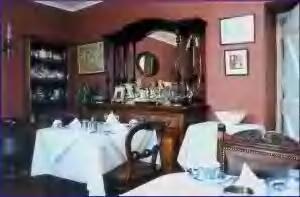Saturday, October 29, 2005
Friday, October 28, 2005
News fron Ireland
A report from one of Ireland's largest banks, AIB,
has indicated that a crash in the Irish housing
market is very unlikely. A recent slow-down in the
rate of increase in house price inflation has ended
and prompted the bank to predict a 7% growth rate
for 2005.
The Irish love affair with property looks set to
continue with as much as 30% of new homes being
snapped up by investors. Over 75,000 new housing
units were built in 2004 and this figure looks set
to be repeated in 2005. Low inflation, high rates
of employment as well as the release of SSIA funds
(savings) in April 2006 are among the main reasons
for the continued optimism.
GOVERNMENT MAY INTRODUCE COMPULSORY PENSIONS
Despite widespread advertising of the need for
citizens to have adequate pensions, the uptake
in private pensions is so low that the Irish
Government may make pensions compulsory.
A recent survey has revealed that 47% of the
workforce have no pension cover, with 60% of
women in employment having no pension cover.
TITANIC DISINTEGRATING RAPIDLY
A deep-sea dive by Irish diver Rory Golden, has
further revealed the extent of damage to the
world's most famous shipwreck. Located in two
pieces, hundreds of yards apart beneath 2.5 miles
of ocean, the Belfast-built ship is disintegrating
at a rapid pace.
A commemorative plaque from Harland and Wolff
shipyard was placed on the wreckage during the
dive.
VESTMENTS OF FAMOUS DUBLIN CHOIR THRASHED
The world famous choir of the historic
Christchurch Cathedral, located in the heart of
Dublin City centre, are having to make alternative
arrangements for their clothing, after their
vestments were thrown out with the thrash.
The red cassocks and white surplices were being
stored in black plastic bin bags prior to a
visit to the dry cleaners. An over-enthusiastic
helper seems to have put them out with the trash
for collection by the City garbage trucks. Valued
at over EURO 20,000 the Choir administrators are
hoping that an insurance claim will cover at least
part of the cost.
The Cathedral is located in the heart of 'Viking'
Dublin and has a history of performing music since
1493. It has existed since the eleventh century
although the current building dates to 1172, the
year of the Strongbow invasion.
ANTI-BIRD FLU MEASURES ARE TIGHTENED
The EU has implemented a complete ban on all
birds into the EU, apart from commercial poultry.
Private owners who wish to import birds from
approved countries must place them in quarantine
for 35 days.
Further regulations are expected in the global
expansion of the measures to prevent the
spread of avian flu.
IRELAND CRASH OUT OF WORLD CUP
The Irish soccer team crashed out of the World
Cup and will not be playing in the finals in
Germany in 2006. A hard-fought 1-0 victory over
Cyprus was followed up by a disappointing 0-0
draw against Switzerland at Landsdowne Road, who
reached the 'play-offs' after finishing second
in the group to France.
The Football Association of Ireland have confirmed
that they will not be renewing the contract of
manager Brian Kerr who must surely be ruing the
points that were dropped by his team in the two
drawn matches against Israel.
Voice your opinion on these news issues here:
http://www.ireland-information.com/cgi-bin/newsletterboardindex.cgi
Thursday, October 27, 2005
Ireland's Beauty
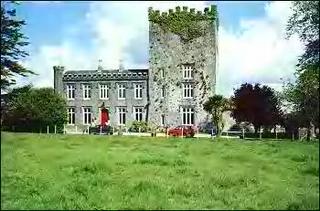
Nature, Beauty and Style. Irish people and the natural elements are never far apart. Irish-made products reflect this harmonious tie, all coming from a world where natural beauty reigns supreme. A world where the natural wonders are given due respect, where ancient woods and hidden gems can tell their mystical tales. The age-old traditions prevail in modern times, reflecting notions of change here and there, reflecting a true Irish heritage, beauty and pride. It's all in the nature of Ireland.
FAR hence, amid an isle of wondrous beauty,
Crouching over a grave, an ancient, sorrowful mother,
Once a queen—now lean and tatter’d, seated on the ground,
Her old white hair drooping dishevel’d round her shoulders;
At her feet fallen an unused royal harp,
Long silent—she too long silent—mourning her shrouded hope and heir;
Of all the earth her heart most full of sorrow, because most full of love.
Yet a word, ancient mother;
You need crouch there no longer or the cold ground, with forehead between your knees;
O you need not sit there, veil’d in your old white hair, so dishevel’d;
For know you, the one you mourn is not in that grave;
It was an illusion—the heir, the son you love, was not really dead;
The Lord is not dead—he is risen again, young and strong, in another country;
Even while you wept there by your fallen harp, by the grave,
What you wept for, was translated, pass’d from the grave,
The winds favor’d, and the sea sail’d it,
And now with rosy and new blood,
Moves to-day in a new country.
Monday, October 24, 2005
Thursday, October 20, 2005
Saturday, October 15, 2005
Where have you Been?
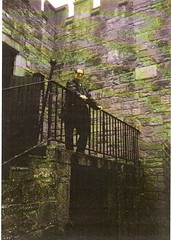
Gentle Readers,
Where am I? I am taking all of my friends and family on a virtual tour of Ireland. You can catch up with us at http://drcallahan.bravejournal.com. We'll be away for a few days but you can join us. Please, Please let me know if you want to come stay a day or two. I need to make arrangements for food and a place to sleep for you all.
Tuesday, October 11, 2005
Christianity in Ireland
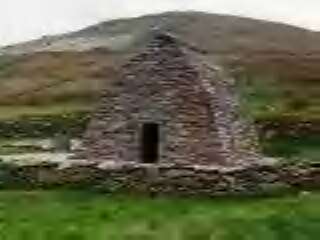
Jesus Christ spent around 30 years in Palestine (what is now Israel) around the year 1 AD. His ministry have been extraordinary, for his followers spread rapidly across the known world with the message that he had taught. The early missions around the eastern Mediterranean are chronicled in the book of Acts in the Bible, as well as the letters of St Paul. Despite widespread persecution under the Romans, during which time thousands of Christians were thrown to the lions or crucified, the Roman Empire ultimately adopted Christianity as its religion. From the Mediterranean it spread northwards into Gaul and it reached Ireland around the late 300s or early 400s.
The first recorded missionary to Ireland was Palladius, who was probably from Gaul [France]. He was sent by the Pope to be bishop to the "Irish who believe in Christ". Patrick himself stated that Palladius' mission was a failure. However, other historical documents from outside Ireland indicate that the mission of Palladius was very successful, at least in Laigin (Leinster), and that he set up a number of churches.
Tradition says that Palladius' visit to Ireland was in the year 431.
St Patrick Perhaps the most famous missionary to Ireland was St Patrick. However, a small point of caution is needed here It is widely believed by historians that the missions of St Patrick were embellished and enshrined by Patrick's monastery at Armagh in their (ultimately successful) bid for primacy over the church in Ireland.
In creating what is referred to as the 'Cult of Patrick', Armagh exaggerated the importance of Patrick and diminished the importance of the other missionaries, possibly even attributing some of the work of these other missionaries to Patrick. That said, St Patrick is such an important part of Irish culture that it would be a mistake to ignore him.
We know very little for certain about Patrick. According to his own "Confession", he was born in Roman Britain - probably near Hadrian's Wall in northern England - the son of a wealthy official. His mother may have come from Gaul [France]. When he was 16, sometime in the early 400s, he was kidnapped by an Irish raiding party and sold into slavery in Ireland. As Roman Britian collapsed, it was increasingly common for Irish, Pict and Saxon raiders to pillage its coastal settlements and it seems that Patrick fell victim to one of these raids. Patrick worked as a slave for 6 years tending sheep, traditionally believed to be on Slemish Mountain, county Antrim, but it seems possible that he was, in fact, somewhere near the Atlantic Ocean in county Mayo or Sligo.
Patrick says in his Confession that he discovered God during his time of captivity, and took to praying a hundred times a day. After 6 years, Patrick managed to escape from captivity, walked the 200 miles to the east coast and managed to negotiate passage aboard a trading ship to Gaul [France]. There, he probably trained to be a Christian Priest and spent time in Auxerre. He then received prophetic dreams where he heard the people of Ireland near the 'western sea' call him to come and walk among them again. He then travelled to Ireland as a missionary, and it seems that he never left. The year traditonally given is 432, but it seems more likely to have been around 460
Patrick concentrated his work in north-east Ireland, and his first church was at Saul, near present-day Downpatrick. He preached to the Kings and their households and met with varied levels of success. One of his methods was to 'Christianize' the Celtic Pagan festivals. For example, Patrick reputedly lit an Easter bonfire on Slane Hill near the Hill of Tara while the King was having his own Pagan bonfire there. The King was enraged, but he took the opportunity to preach and managed to make some converts.
He is famously said to have used the 3-leaved Shamrock to explain the concept of the Trinity: God as the Father, Son and Holy Spirit (although some believe this story is a myth). Patrick died in Ireland and is traditionally believed to be buried on the Hill of Down in Downpatrick, county Down. A stone marking the traditional burial spot was added in 1901 and the site is now a popular tourist attraction.
Saturday, October 08, 2005
An Irishman and His Philosophy
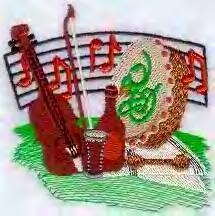
A lecturer, when explaining stress management to an audience, raised a glass of water and asked, "how heavy is this glass of water?" Answers called out ranged from 20g to 500g. The lecturer replied, "The absolute weight doesn't matter. It depends on how long you try to hold it."
"If I hold it for a minute, that's not a problem. If I hold it for an hour, I'll have an ache in my right arm. If I hold it for a day, you'll have to call an ambulance. In each case, it's the same weight, but the longer I hold it, the heavier it becomes."
He continued, "And that's the way it is with stress management. If we carry our burdens all the time, sooner or later, as the burden becomes increasingly heavy, we won't be able to carry on. As with the glass of water, you have to put it down for a while and rest before holding it again. When we're refreshed, we can carry on ! with the burden."
"So, before you return home tonight, put the burden of work down. Don't carry it home. You can pick it up tomorrow. Whatever burdens you're carrying now, let them down for a moment if you can." "Relax; pick them up later after you've rested. Life is short. Enjoy it! And then he shared some ways of dealing with the burdens of life:
* Accept that some days you're the pigeon, and some days you're the statue.
* Always keep your words soft and sweet, just in case you have to eat them.
* Always read stuff that will make you look good if you die in the middle of it.
* Drive carefully. It's not only cars that can be recalled by their maker.
* If you can't be kind, at least have the decency to be vague.
* If you lend someone $20 and never see that person again, it was probably worth it.
* Never buy a car you can't push.
* Never put both feet in your mouth at the same time, because then you won't have a leg to stand on.
* Nobody cares if you can't dance well. Just get up and dance.
* Since it's the early worm that gets eaten by the bird, sleep late.
* The second mouse gets the cheese.
* When everything's coming your way, you're in the wrong lane.
* Birthdays are good for you. The more you have, the longer you live.
* You may be only one person in the world, but you may also be the world to one person.
* Some mistakes are too much fun to only make once.
* We could learn a lot from crayons. Some are sharp, some are pretty and some are dull. Some have weird names, and all are different colors, but they all have to live in the same box.
* A truly happy person is one who can enjoy the scenery on a detour.
And so Gentle reader that's where we start to live life Because, "Life is worth Living"!
Friday, October 07, 2005
Byways rather than Highways
In 1988 we took the road to the north coast of County Mayo and later were even more adventurous and travelled westwards through the bogland of Bangor Erris. But we never reached quite as far as the extraordinary peninsula of the Mullet. Nearly fifty years ago, I lodged on my first visit there in the bleak B&B which was the only accommodation on offer. The Mullet was wild and windswept and it remains that way. But now there is a thriving community, a splendid new hotel and a good range of accom-modation, so that Belmullet can be recommended as a base for a holiday in one of the least frequented and most remote regions of Ireland.
Begin in Ballina – the ‘town of the ford’ which stands or spreads where the River Moy meets the tide that flows in from Killala Bay. The Ballina Angling Centre, overlooking the best beat on the river, is worthy of a visit simply to gaze in awe at the multitude of colourful lures that may be used to entice the fishes. You leave Ballina by the road for Killala, eight miles to the north and something of a gateway to the wilderness. There are tempting diversions on the way there. A right turn, two miles out from Ballina leads to the secluded demesne of Belleek, a lovely area of forest and parkland.
In Killala an ancient round tower and a 17th century cathedral stand above the harbour, separated from it by a most delightful conglomeration of narrow streets and neat old houses. A peaceful spot nowadays, Killala earned fame in ‘The Year of the French’ when French troops, under the command of General Humbert, landed nearby to support the great republican rising of 1798. Belleek demesne was a place of lush woodland, with magnificent old trees and a big house spoke of affluence.
A few miles to the west, the Céide Fields Centre makes a much more convenient viewing point – with archaeology, a museum and food as added attractions. The Centre, a beautiful structure of glass and steel whose interior walls display well-deserved architectural awards, celebrates the archaeological discoveries of Séamus Caulfield who unearthed the boundaries of Stone Age fields. Guided tours are available, but be sure to climb the stairs to see the little museum which explains the scenery and gives access to the pinnacle of the building and a breathtaking view of seaside and moorland scenery.
After passing Carrowmore Lake on the left, the road heads for the Mullet, by way of a narrowing spit of land, with Blacksod Bay to the left and Broadhaven to the right. Belmullet, with its crossroads lined by 19th century shops and dwellings. Go straight through the village and turn left at the crossroads to take the road for Blacksod. A region of green pasture, with delightful sandy beaches and seething with geomorphological phenomena; the underlying rock is described as ‘Pre-Dalradian’.
The surface of much of the Mullet is a very special landform called machair, produced by a combination of sand blowing in the wind and sheep grazing. but we will pass this by and head for the village of Blacksod, with its ancient lighthouse and modern pier. A little plaque on the wall of the lighthouse commemorates the former weather station there and the fame it earned in providing vital information which determined the date of the D-day landing of 1944.
Eventually you meet the sea again, in the shape of the busy sheltered inlet of Bellacrogher Bay where they farm delectable salmon and mussels. A sudden re-appearance of woodland announces imminent departure from the wilderness and a descent to the long-established, though exclusive, seaside resort of Mallaranny. You can stay there in the recently restored 19th century railway hotel or one of many smaller lodgings. Or you might head east for the modern world or west for the remote, but totally accessible and welcoming, island of Achill.
Distances miles km
Ballina-Killala 8 13
Killala-Downpatrick Head 12 20
Downpatrick Head-
Céide Fields 9 14
Céide Fields-Belmullet 25 40
Belmullet-Blacksod 12 20
Blacksod-Bangor 24 39
Bangor-Mallaranny 17 28
Total 107 174
Wednesday, October 05, 2005
The Celts

The Celts were a population of warriors, and at the same time they were guided by a deep spirituality. They came from a land close to the sources of the Danub river, their dominion spread over Central Europe, the British Isles and Spain.
Their golden age was in the 5th and 4th century b. C., when the greatest conquers took place. From 300 b.C. the Celtic political cohesion and military power began to decline, making the Roman invasion easy: at the beginning of the Christian era the Gauls and the Britons were under the Roman rule.
Ireland was never conquered nor visited by the Roman army: the Celtic civilization and traditions could survive there, unaltered, until the spreading of the evangelization.
The Megalithic Population and the Celts
Before the rising of the Celtic civilization, the western part of Europe was inhabited by a mysterious population, called "Megalithic population". They built the stone funeral buildings, such as dolmens, menhirs, stone circles, passage graves (like Newgrange, in the Boyne valley, Ireland), which can be found from Scandinavia to Gibraltar, on the Spanish coasts, in Greece, on the Northern coasts of Africa, even in Arabia, India and Japan.
This population seems to be of north-African origin; they entered Europe through the Strait of Gibraltar. The decorations engraved on the stones of Newgrange, in Ireland, seem to confirm this theory. The grave was later considered by the Celts as the dwelling of the Sidhe, or the Fairy People, and it was chosen as the burial place of the kings of Ireland. The most recurring symbol on the stones of Newgrange is the spiral, a very common symbolic decoration on almost every megalithic building.
A symbol of particular interest can be observed at Newgrange: the "boat with the sun".
The boat with the sun
A lot of similar images can be found on megalithic buildings in Bretagne, Sweden, etc., but the most interesting similarity is the image of the boat with the sun in Egypt, representing the boat shipping the dead to the next world.
Boat (Bretagne)
Boat (Sweden)
Egyptian boat
Since Newgrange had a funeral function, the meaning of the symbol seems to be the same, giving evidence to the theory of the African origin of the Megalithic Population.
The belief in the immortality of the soul, acquired thanks to the contact with the Megalithic Population (which the Celts conquered, mixing with them), became the main feature of Celtic Druidism. The deep faith in the next world gained the priestly caste of Druids a great power. Druidic schools were crowded, in spite of the strict rules pupils had to respect. Students were taught arts and science, the moving of stars, the size of universe, the power of gods.
Myths
Mythological Cycle of the Origins of Ireland
Partholan: The Celts considered themselves as descendants from the god of death, and they believed that they came from the land of the dead, which was not a dark and terrible place, but a very luminous and happy land, which they called "land of the living people" or "land of the happy dead". The founder of Ireland, Partholan, came from this place.
The Fomori: they were gigantic, hideous, violent and cruel creatures, representing evil powers. Partholan, the founder of Ireland had to fight against them, and sent them away to the Northern Sea, but they occasionally came back and frightened the country.
The Nemed population: these people and Partholan had the same origin. They came to Ireland after the dead of Partholan’s people due to a disease. They had to fight against the Fomori, but they were defeated; only thirty people survived, and they left Ireland in despair.
The Tùatha Dè Danann: also called Danu’s people, mythological settlers of Ireland. Their name means "the people of the god whose mother is Danu". Danu is sometimes called Brigit, a vey popular goddess in celtic Ireland. They came to Ireland from the sky, carrying two objects, the Danann’s treasure: the Stone of Fate, on which the kings of Ireland were crowned, and a magic sword. They ruled over Ireland until the arrival of the Sons of Miled. They had a great number of gods, which will be described later. The Danann had divine characteristics, and they were considered as protectors of arts and science.
The people of Miled’s sons: they came to Ireland when it was governed by the Danann, on the first of May, the day dedicated to Beltenè, the god who gives and takes life. They defeated the Danann, who remained in Ireland, wrapped in a veil which gave them invisibility and could be worn and taken off whenever they liked. Ireland was since inhabited by two populations: the human one, and the supernatural one, the Danann, who could not be seen by men, unless they wanted to be seen and to cooperate with them. The Danann were later called People of Sidhe. They represent the Celts’ love for science, poetry, music.
Gods and mythological heroes
Dagda Mor: father of the Danann. He is a warrior and a musician, he has a harp which flies to him when he calls it.
Angus Og: Dagda’s son, he is the Irish god of love. His kisses had the shape of four birds, which inspired love to young people with their singing.
Lugh: the son of Kian, the god who represents the sun in the whole Celtic world. Lugh is the god of light.
Balor: king of the Fomori, he is also one of the gods of darkness and evil.
Goddess Danu: Dagda Mor’s daughter, she gave birth to the father god of the Danann. She is the goddess of fertility and fruitfulness.
Morrigan: goddess of war and violence, she liked causing hatred and fighting among men, assuming terrible looks. She often appeared as a crow.
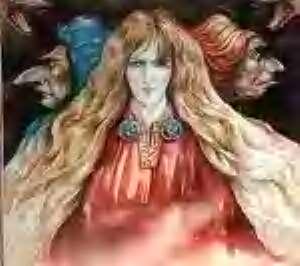
Morrigan
Erinn (or Erin): poetic name of Ireland, it comes from the name of goddess Eriu, wife of Mac Grené, Dagda Mor’s grandson and descendant from the sun.
Cuchulain: one of the bravest Celtic heroes, leader of Ulster. He has divine origins: his father is Lugh, god of light. His name means "Cullan’s dog". Cullan had a fierce dog, which protected his house. Cuchulain was attacked by the dog and killed it. To amend, he convinced Cullan to give him one of the killed dog’s puppies and he trained it to defend Cullan’s home. He also offered Cullan his protection . His generosity was publicly praised and he was nicknamed Cuchulain, or "Cullan’s dog".
Skatha: warrior woman, she trained the young fighters, Cuchulain was trained by her.
Tara: hill where all the mythological kings of Ireland dwelled.
Finn mac Cumhal and the Fianna of Erin: Finn is the hero of the Ossianic cycle, he is the leader of the Fianna, a military stock, which prevented foreigners from invading Ireland. His ancestors were Danann.
Oisin (or Ossian):Finn’s son, he is a poet, as well as a warrior. He is the author of the Ossianic Cycle, which deals with his father and the Fianna.
Oscar: Oisin’s son, the greatest Fianna warrior.
Druidism and religion
The Druids
The Celtic word was dru-vis or druvid, from dru= very e wis= wise. Druids were therefore protectors of knowledge, and they played a relevant role in the whole people’s life. They were priests, magicians, physicians, depositories of the laws.
The term "druid" generally refers to the priestly class of the Celts, but within this class a lot of different tasks can be actually found. In Ireland, together with the Druids, holders of the supreme knowledge, we can find the file, poets who knew and preserved the ballads, which were orally transmitted. Some of them had the task of memorizing the laws and repeating them during the trials.
Many years of hard studying were required to become a druid, and only the best students could aim at the title. It was not a closed caste. Druids were involved in the life of the whole community, but the supreme druid was an important king’s alley. Druids cannot become kings, being in charge of the spiritual life, but the king had to keep their opinion into account and had to show respect to them.
Magic
The Celts considered both this world and the next one as part of the reality. They considered themselves as descendants of the god of the next world, a happy and luminous place. Their reality consisted of gods, heroes and common men. Nature played a very important role, it was a sort of magical alley of man, and an important element in the magic practice.
Oak was the holy tree, and an oak-wood was a sacred place. Mistletoe, growing on oaks without roots in the ground, was considered as a gift that the gods sent from the sky, and had magic and healing properties. It had to be reaped without letting it fall to the ground and without cutting it with any iron tools.
Yew was another sacred tree, from which druids made wands used during the magic rituals.
Hazel tree was the tree of knowledge, by eating its fruits a man could increase his knowledge. According to a legend, there was a little lake by a wood of hazel-trees, inhabited by five salmons, which fed only on the hazel-nuts from the wood. They were the salmons of knowledge, and by eating one of them, Finn mac Cumhal acquired a great knowledge.
Apple is the fruit of immortality, when it’s cut in half, it shows the five points star, symbol of the sun.
Water symbolizes fertility and purity, it is a purifying and healing element. There are a lot of legends dealing with holy and healing sources. The sea is one of the borders between the real world and the next one. Druids can control the waves.
Druids are also lords of the fire, which has great ritual properties, as a purifying element, source of light, which overcomes darkness and evil, and source of heat.
The time
Druids had also the task of studying the moving of stars, calculating the calendar and deciding the best time for the activities in the fields.
Celts divided the year into two seasons: the season of the dark months, and the season of the luminous months: winter (which began on Samain) and summer (which began on Beltane). The year started during the dark season, with the sacred celebration of Samain, a real new year’s day, taking place on the present november 1st.
The Celts thought that during this celebration the real world and the next one came into contact, and reality and supernatural mixed together, making the strangest things possible. The celebration started three nights before november 1st, and it closed three nights after that day. No kind of violence or fighting was allowed during this period. The trial weddings established in summer which had failed the test of time and were not a happy union, could be dissolved.
The feast celebrated the end of a natural and productive cycle, the temporary "death" of nature, which was preparing to face a new cycle. The feast survives nowadays with the still "pagan" feast of Halloween, and with the religious cult of the dead, which preserves the Celtic idea of the contact with the next world.
The opposite of Samain is Beltane, which, on May 1st, celebrates the mild and luminous season. Fires were lit at night, and this tradition is still alive nowadays, with the fires lit to celebrate the patron saints during the popular feasts.
There were also two celebrations in between: Imbolc, three months after Samain, on February 1st, which celebrated the return of milk to the sheep, and the end of the worst part of winter; and Lugnasad, on August 1st, celebrating the god of light, Lugh and the reaping of fruits. During this feast commercial trades and weddings were carried out.
The "infinite knot"
The Celtic religion seems to be polytheistic, but the numerous gods were actually different aspects of a divine spirit, which spreads through the whole universe. The spirit is responsible for the flowing harmony of the universe. Human life is only the central part of a longer existence. The spirit permeates the whole nature, which the Celts perceived as a friend, something similar to them, sharing the same spirit. Reality is therefore a plot of infinite existing elements, both living and inanimate, such as stones, water and fire. All these elements are linked by the common spirit, which exists in everything. The graphic representations, which can be found in great number in a variety of decorations, are the "infinite knot" and the "spiral"(recurring everywhere, also turned into a Triskell), to symbolize the never ending evolution of the universe.
Infinite knot
Triskell
Triple spiral
Monday, October 03, 2005
Speak Irish Like the Irish
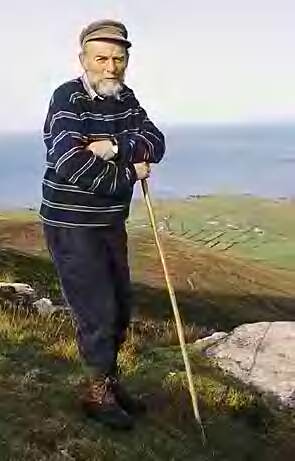
Irish people communicate and the way Americans do is through variations in diction. Almost all amateur impostors overlook this very important distinction between the two schools of speech. To illustrate, think of someone affecting the typical Valley Girl voice: "like, totally, speaking this way dude - I mean, fer sure, right?!" In that one nauseating sentence, you can immediately identify the caricature; not from the accent (no one spoke those words to you) but simply from the words themselves.
People from different regions not only sound different, but actually use a different vocabulary of words. You cannot successfully put on an Irish accent simply by mastering the different tonalities and inflection of the Irish, you must also adopt their lexicon.
If asked how an Irishman is doing, for example, he's likely to reply, "Grand." When was the last time you heard an American say "Grand" unless they were referring to $1,000 or a piano? We'll give you a quick glossary here of choice Irish words for a variety of settings, but this space will be nowhere near big enough to cover all that you'll need to learn. So review this list and then we'll point you to other good sources to expand your store even further.
We've dedicated our limited space to the three topics most prevalent in Irish interlocution: general chats, anger, and food.
The general chat
Em This is the word Irish folk use when pausing to think. It takes the place of the "um" and "uh" that Americans prefer. This two-letter word alone will radically alter your perceived Irishness if you can learn to use it pervasively and unconsciously. This is perhaps the single most commonly used expression in speech, so with this one change alone, you can drastically alter your accent.
Cheers This word is obviously a drinking toast, but more importantly, it is an-all purpose aloha-like tool. You can use it to thank people, to greet them, and to say goodbye. Work it in liberally.
Lad Any male, though usually one of whom you're fond; when pluralized, it can be used to describe a group of males and females.
C'mere Literally, "come here," but it is really just an opening expression that means, "listen" or even just "hey." So if you ever want to get someone's attention, or to begin almost any sentence, bust this out. C'mere, do you follow?
Right This is another all-purpose expression of determination or clarification. "Right, is that a gin & tonic for you and a pint for your friend?" or "Right, you'll be coming home with me then?" If you don't open with "c'mere," this is your other option.
Fag A cigarette. This is an important one, be sure to get it right.
Anger
Bastard Not simply a child born out of wedlock, but also an adjective of angry frustration: "where's my bastard coat?"
Eejit Idiot, but harsher.
Knacker Literally, to convert a horse into glue, but more conventionally, just very tired, exhausted.
Food
Chips French fries. Though in Ireland, they're more like steak fries: lovely and thick, slathered in grease, and unbelievably tasty.
Crisps Potato chips. Usually available in two flavors: cheese n' onion or salt n' vinegar.
Bangers Sausages. Thicker and curvier than hot dogs, and almost always fried or deep-fried, sometimes even in batter if you can imagine.
Mash Mashed potatoes. This usually accompanies bangers.
Fry A collection of pretty much anything that can be fried, usually for breakfast. So if you're proposing a fry, you'll need to contemplate eggs, bacon (rashers), bangers, black pudding (blood sausage), white pudding (more blood sausage), mushrooms, tomatoes, etc. Basically, a heart attack on a plate, but delicious.
Biscuit Something more like a cookie than the southern item. To be taken with tea, usually.
Peckish The feeling of hunger.
Clearly, we cannot arm you with all the charming Irish trappings that you will need to pass yourself off as a Hibernian effectively. But these phrases should tide you over until you have a chance to read plenty of Irish poetry, which will disgorge plenty of idioms to you. In the meantime, here are a few good web sites that span the bridge between American and British. As much as it galls us to say so, learning the Britishisms is fairly close to learning Irish.
http://www.geocities.com/Athens/Atlantis/2284/
http://pages.prodigy.com/NY/NYC/britspk/main.html
http://www.effingpot.com/
http://www.wmin.ac.uk/~sfgva/ukus.htm
http://www.scit.wlv.ac.uk/wwlib/american.html
As you go forth to apply yourself to this most worthy of pursuits, bear in mind the words of that immortal Irish bard, G.B. Shaw, who reminds us that "Ireland and America are two nations separated by a common language." Okay, so he said England and America, but we'll take some artistic license.
Sunday, October 02, 2005
Irish Humor
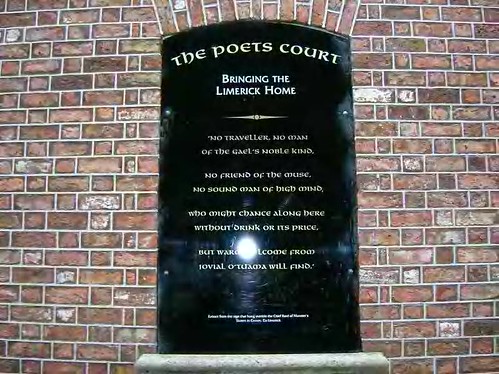
Some say that the Irish zest for humor began long ago, even before St. Patrick, the patron saint of Ireland, who brought the love of learning and Christianity to the Emerald Isle.
Fanciful historians believe the appetite for humor originated in the dim, distant past with two contentious groups: the legendary leprechauns of the south and the pookas of the north. Both were mischief-makers who started all kinds of shenanigans to tease each other. It is from these "wee people" that the Irish supposedly inherit their ready wit and quick tongues. From them flowed the limericks, blarney, the "Irish Bull", and the rib-tickling repartee of sophisticates like Oscar Wilde and George Bernard Shaw.
Tradition has it that whoever kisses the stone at Blarney Castle in County Cork will be blessed with the gift of eloquence. One unknown poet put it this way:
The stone this is whoever kisses,
He never misses to grow eloquent.
'Tis he may clamber,
To my lady's chamber,
Or be a member of Parliament.
Monsignor Fulton Sheen, the famous TV cleric of the late '50s made this nice distinction between baloney and blarney. He said, "Baloney is so thick it cannot be true; blarney is flattery so thin we like it."
As to the lusty lilt of a limerick, its fountainhead spilled over in bygone days in Munster, where partygoers would sing "Will You Come Up To Limerick?" Later the 5-line verse form was adopted by sailors and soldiers, travelers and tinkers, and as time went by the limerick became increasing salacious. But, here is one that is not only "clean" but comical:
A limerick packs laughs anatomical
Into space that is quite economical:
But the good ones I've seen
So seldom are clean
And the clean ones so seldom are comical.
Here's another type of verse. The poem is called "The Tides of Love." It goes like this:
Flo was fond of Ebenezer --
"EB" for short, she called her beau.
Talk of Tides of Love, great Caesar!
You should see them -- Eb and Flo.
Oscar Wilde was probably the great wit of his time; his one-liners are genuine masterpieces. Here are a couple of good lines that Wilde tossed off. "I can resist everything except temptation." And "I never put off till tomorrow what I can possible do -- the day after."
And speaking of humor itself, Wilde remarked that "Humanity takes itself too seriously. It is the world's original sin."
An "Irish Bull" is not an animal that bellows and chases cows in a pasture. Instead, it is a humorous devise similar to a malapropism. Here, for example, is an "Irish Bull". Two weary lads on foot are traveling to town one hot summer day when they suddenly realize they still have 10 more miles to go. "Sure", said one, who was an optimist, "take heart, that's only five miles apiece."
Then there's the tale about the young preacher who blessed his congregation with this brief and fervent prayer. "May all of you be filled with fresh veal and zigor."
And last but not least is a beautiful Irish blessing that is not humorous but is filled with good cheer and warm sentiment:
"May the roads rise to meet you,
May the wind be always at your back.
May the sunshine warm upon your face,
The rains fall soft upon your fields, and
May God Hold you in the palm of His hand."



